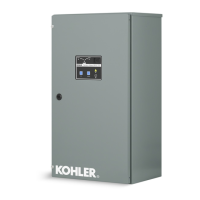TP-6461 1/0860 Section 4 Controller Test and Replacement
4.4 Sequence of Operation
4.4.1 Controller Powerup Reset
Sequence of Operation
Following is an explanation of the sequence of operation
for the MPACt 1500 ATS Controller when power is
initially applied to the controller or a controller reset
occurs.
1. Controller self test is executed.
2. System parameters are downloaded from
non-volatile memory.
3. Contactor position and source availability are
determined.
4. If neither source is acceptable, the contactor does
not change position.
5. If both sources are available, the controller
immediately transfers the contactor to the
preferred source.
6. If only one source is available, the controller
immediately transfers the contactor to that source,
executing only the off-position and load control
time delays.
If the available source is the preferred source, and
the contactor was in the standby position, the
contactor transfers to preferred, the engine
cooldown time delay runs, and then the engine
start contacts open.
If the available source is the preferred source and
the contactor was already in the preferred position,
the engine start contacts open immediately,
bypassing the engine cooldown time delay.
4.4.2 Preferred Source Loss and Return
Following is an explanation of the sequence of operation
for MPACt 1500 ATS Controller when Preferred
Source failure is detected.
Preferred Source Fails:
1. Load control contacts open.
2. Time delay engine start times out.
3. The generator is signaled to start.
4. The generator starts and the standby source
becomes available.
5. Time delay preferred-to-standby times out.
6. Contactor transfers to standby.
7. Post-transfer load control sequences time out.
8. Load control contacts close.
Preferred Source Returns:
1. Time delay standby-to-preferred and pre-transfer
load control sequences time out.
2. Load control contacts open.
3. Contactor transfers to preferred source.
4. Post-transfer load control sequences and time
delay engine cooldown time out.
5. Load control contacts close.
6. The generator is signaled to stop.

